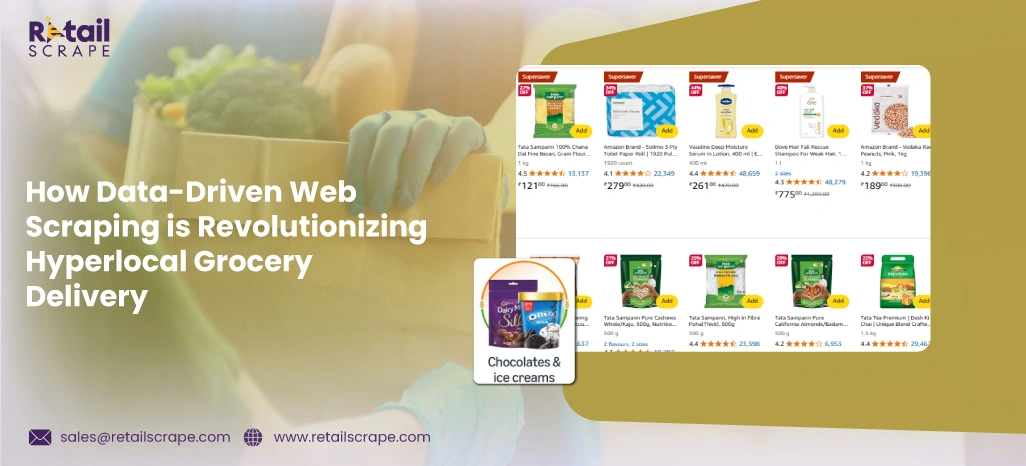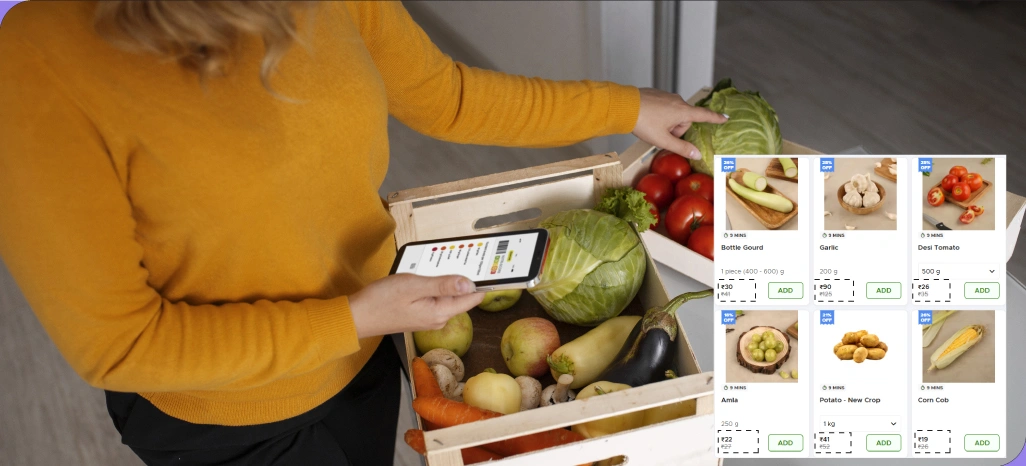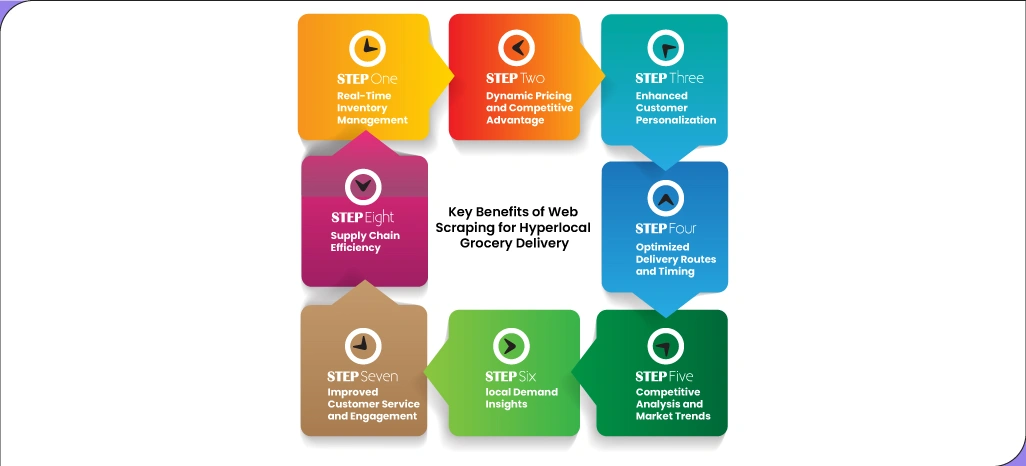
Introduction
In today’s fast-paced, tech-driven world, hyperlocal grocery delivery has emerged as a highly competitive and rapidly growing market. With the rise of e-commerce and the increasing consumer demand for fast, convenient shopping experiences, businesses in the hyperlocal grocery delivery space must constantly evolve to meet these expectations. At the heart of this evolution lies data-driven web scraping, a powerful tool that enhances various aspects of hyperlocal grocery operations, from pricing to logistics and customer personalization.
This article will delve into how web scraping for hyperlocal grocery delivery can provide a competitive edge for businesses, transforming operational efficiency, improving customer satisfaction, and optimizing delivery systems. We’ll also discuss grocery data scraping services and their role in unlocking the full potential of on-demand hyperlocal grocery delivery.
What is Data-Driven Web Scraping in Hyperlocal Grocery Delivery?

Web scraping involves using automated tools to extract useful data from websites, transforming it into structured formats that can be analyzed and utilized by businesses. When it comes to hyperlocal grocery platforms, web scraping is an essential tool for gathering real-time information from grocery stores, e-commerce platforms, and even competitors.
Through grocery data scraping services, businesses can collect data on product availability, pricing, customer preferences, competitor strategies, and even local delivery conditions. This data is then analyzed to help companies improve decision-making processes, increase operational efficiency, and deliver better services to customers in the hyperlocal grocery delivery market.
Key Benefits of Web Scraping for Hyperlocal Grocery Delivery

1. Real-Time Inventory Management
One of the most pressing challenges faced by businesses in the hyperlocal grocery delivery market is ensuring real-time product availability. Traditional methods of managing inventory can be slow, leading to stockouts and unhappy customers. With web scraping, businesses can track real-time inventory levels from various grocery stores and e-commerce platforms, ensuring that customers only see available products.
Web scraping for hyperlocal grocery delivery allows businesses to pull data from multiple sources to gain a holistic view of inventory. By tracking stock levels and availability across various stores, delivery services can offer more accurate product listings to customers. Additionally, when products are out of stock or discontinued, businesses can quickly remove them from their platforms, ensuring that customers have an up-to-date view of what’s available for delivery.
2. Dynamic Pricing and Competitive Advantage
The hyperlocal delivery solution market is highly competitive. Businesses need to stay nimble, adjusting prices in real-time to respond to market changes, competitor movements, and demand fluctuations. Web scraping allows businesses to track competitors’ pricing across different platforms, helping them adjust their own prices for specific products or categories.
For example, if a competitor raises the price of a commonly purchased grocery item, a business can quickly modify its price or launch a promotion to stay competitive. Grocery data scraping services provide businesses with the insights needed to implement dynamic pricing strategies that help attract more customers while maintaining profitability.
3. Enhanced Customer Personalization
Personalization is key to improving customer loyalty and driving repeat business in the hyperlocal grocery sector. Data-driven web scraping enables businesses to collect valuable customer data, including browsing behavior, purchase history, and preferred product categories. By analyzing this data, businesses can recommend personalized offers, suggest frequently purchased items, or alert customers when their favorite products are back in stock.
For example, by scraping customer reviews and preferences, hyperlocal grocery platforms can suggest customized bundles, promotions, or discounts that are tailored to the customer’s tastes. This level of personalization builds trust, improves the shopping experience, and encourages customer retention.
4. Optimized Delivery Routes and Timing
The speed and efficiency of delivery are crucial factors in customer satisfaction. On-demand hyperlocal grocery delivery services need to ensure that their delivery teams are following the most efficient routes, especially during peak hours or in busy urban areas. Web scraping plays a vital role in optimizing delivery logistics.
Scraping traffic data from real-time sources, such as traffic apps or local news sites, allows businesses to adjust delivery routes dynamically. If a major traffic jam or roadblock is reported, businesses can reroute deliveries to avoid delays. Additionally, web scraping can help businesses track local weather conditions, ensuring that deliveries are not delayed by bad weather.
5. Competitive Analysis and Market Trends
Understanding what competitors are doing is essential in a competitive environment like hyperlocal grocery delivery. By using grocery data scraping services, businesses can keep a close eye on competitors’ pricing, promotions, inventory levels, and customer engagement strategies. This helps businesses stay ahead of trends and anticipate market shifts.
Web scraping tools can collect data from various competitors’ websites, social media, and review platforms. Analyzing this data can provide insights into customer preferences, product trends, and emerging demands. For example, if competitors are seeing success with a new organic product line, businesses can quickly assess whether to introduce similar products to their own offering.
6. Local Demand Insights
In hyperlocal delivery, businesses need to understand the unique demands of each geographic area they serve. Web scraping can gather data about local grocery preferences, seasonal trends, and consumer behavior. This data helps businesses tailor their product offerings to match regional tastes and buying habits.
For instance, scraping weather data can indicate when certain products, such as hot beverages or fresh produce, will see an uptick in demand. Analyzing local event data can also help businesses understand when to anticipate high demand in specific neighborhoods. This level of localized insight allows businesses to optimize their inventory and delivery operations for each unique market.
7. Improved Customer Service and Engagement
Customer engagement is a vital component of long-term success in the hyperlocal grocery delivery market. By scraping data from online review platforms, businesses can gain insights into customer satisfaction, feedback, and complaints. This data enables businesses to quickly address customer concerns, improve their services, and engage customers more effectively.
Web scraping can also provide valuable insights into product ratings and customer sentiment. By analyzing customer feedback on competitors’ sites, businesses can identify areas of improvement, such as enhancing product quality or adjusting delivery times. Proactive customer service based on data-driven insights helps foster customer loyalty and positive reviews.
8. Supply Chain Efficiency
A well-managed supply chain is crucial to maintaining fast, cost-effective delivery in the hyperlocal delivery solution industry. Web scraping can help businesses streamline their supply chain by tracking supplier prices, product lead times, and stock levels. By continuously monitoring supplier websites, businesses can make smarter procurement decisions, avoid stockouts, and reduce excess inventory.
Additionally, grocery data scraping services can provide valuable insights into product trends, allowing businesses to predict demand more accurately. This helps reduce overstocking or understocking, ensuring that the right products are available at the right time.
How to Implement Data-Driven Web Scraping for Hyperlocal Grocery Delivery?

To fully leverage the benefits of data-driven web scraping for hyperlocal grocery delivery, businesses must implement a structured approach. Here’s how to get started:
1. Identify Key Data Sources
Start by identifying the most relevant data sources for your business. These could include grocery store websites, competitor platforms, local traffic and weather services, and social media. Focus on gathering data that directly impacts your business operations, such as inventory levels, pricing, local demand patterns, and customer behavior.
2. Choose the Right Web Scraping Tools
Select web scraping tools that suit your business needs and technical capabilities. Some tools are more user-friendly, while others are better suited for handling large volumes of data. Consider automation capabilities, ease of integration with other systems, and scalability when choosing your scraping tools.
3. Collect Real-Time Data
Set up scraping processes that collect real-time data from the selected sources. For hyperlocal grocery delivery, it’s essential to ensure that inventory and pricing data are always up-to-date. Scraping in real time allows businesses to make immediate adjustments based on current market conditions.
4. Analyze and Act on the Data
Once the data is collected, analyze it to uncover valuable insights. This could involve identifying pricing trends, demand fluctuations, or customer behavior patterns. Use data analytics tools to extract actionable insights and apply them to optimize your business operations.
5. Continuously Improve
Web scraping isn’t a one-time effort—it’s an ongoing process. Continuously monitor your scraping processes and adjust your strategies based on performance metrics. Regularly assess key areas such as customer satisfaction, inventory levels, and delivery efficiency to ensure that your business is meeting its goals.
Conclusion
The future of hyperlocal grocery delivery lies in embracing technology to meet the growing demands of consumers. Data-driven web scraping plays a critical role in this transformation by providing businesses with real-time, actionable insights to improve inventory management, optimize pricing, personalize customer experiences, and enhance delivery logistics.
By leveraging grocery data scraping services, businesses can stay ahead of competitors, drive customer satisfaction, and optimize every aspect of their operations. Whether it’s through on-demand hyperlocal grocery delivery, hyperlocal delivery solutions, or hyperlocal grocery platforms, businesses that adopt data-driven strategies will be better positioned for long-term success.
Ready to elevate your business with data-driven web scraping? Contact us today to learn how we can help you optimize your operations and stay ahead in the competitive world of hyperlocal grocery delivery.
